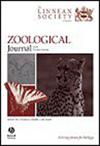Biogeography and phylogeny of the scavenging amphipod genus Valettietta (Amphipoda: Alicelloidea), with descriptions of two new species from the abyssal Pacific Ocean
IF 3
2区 生物学
Q1 ZOOLOGY
引用次数: 0
Abstract
Valettietta Lincoln & Thurston, 1983 (Amphipoda: Alicelloidea) is an infrequently sampled genus of scavenging amphipod, with a known bathymetric range from 17–5467 m encompassing a variety of habitats from anchialine caves to abyssal plains. Molecular systematics studies have uncovered cryptic speciation in specimens collected from the abyssal Pacific, highlighting uncertainty in the description of Valettietta anacantha (Birstein & Vinogradov, 1963). Here, we apply an integrative taxonomic approach and describe two new species, Valettietta trottarum sp. nov. and Valettietta synchlys sp. nov., collected at abyssal depths in the Clarion-Clipperton Zone, Pacific Ocean. Both species can be distinguished by characters of the gnathopods, uropod 3, and the inner plate of the maxilliped. Further, molecular phylogenetic analyses of two mitochondrial (16S rDNA and COI) and two nuclear (Histone 3 and 28S rRNA) regions found both new species to form well-supported clades and allowed us to re-identify previously published records based on genetic species delimitation. The biogeography of Valettietta is discussed in light of these re-evaluated records, and a new taxonomic key to the genus is provided. These new taxa highlight the strength of applying an integrated taxonomic approach to uncover biodiversity, which is critical in regions being explored for potential industrial purposes.清道夫片脚类动物Valettietta属(两栖类:Alicelloidea)的生物地理学和系统发育,以及来自太平洋深海的两个新物种的描述
Valettietta Lincoln & Thurston, 1983 (Amphipoda: Alicelloidea) 是一个很少采样的清道夫两足类属,已知的水深范围为 17-5467 米,包括从锚系洞穴到深海平原的各种栖息地。分子系统学研究发现,在太平洋深海采集的标本中存在隐性物种,这凸显了对 Valettietta anacantha(Birstein & Vinogradov, 1963)描述的不确定性。在此,我们采用综合分类方法描述了两个新物种,即在太平洋克拉里昂-克利珀顿区深海采集的 Valettietta trottarum sp.这两个物种都可以通过钩足、尿足 3 和上颚内板的特征加以区分。此外,对两个线粒体区(16S rDNA 和 COI)和两个核区(组蛋白 3 和 28S rRNA)进行的分子系统学分析发现,这两个新物种都形成了支持良好的支系,并使我们能够根据遗传学上的物种划分对以前发表的记录进行重新鉴定。根据这些重新评估的记录,我们讨论了 Valettietta 的生物地理学,并提供了该属新的分类检索表。这些新的分类群凸显了应用综合分类学方法揭示生物多样性的优势,这对于正在为潜在工业目的进行勘探的地区至关重要。
本文章由计算机程序翻译,如有差异,请以英文原文为准。
求助全文
约1分钟内获得全文
求助全文
来源期刊
CiteScore
6.50
自引率
10.70%
发文量
116
审稿时长
6-12 weeks
期刊介绍:
The Zoological Journal of the Linnean Society publishes papers on systematic and evolutionary zoology and comparative, functional and other studies where relevant to these areas. Studies of extinct as well as living animals are included. Reviews are also published; these may be invited by the Editorial Board, but uninvited reviews may also be considered. The Zoological Journal also has a wide circulation amongst zoologists and although narrowly specialized papers are not excluded, potential authors should bear that readership in mind.

 求助内容:
求助内容: 应助结果提醒方式:
应助结果提醒方式:


